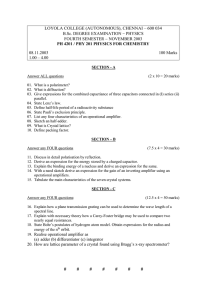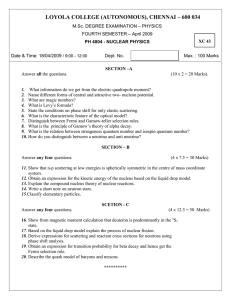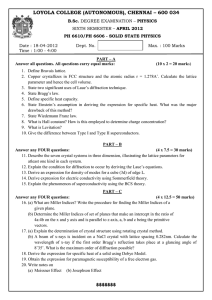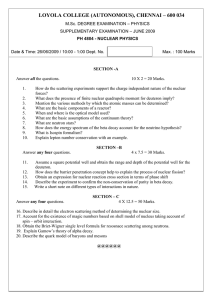1. (a) Discuss in detail the polarization of EM waves through
advertisement
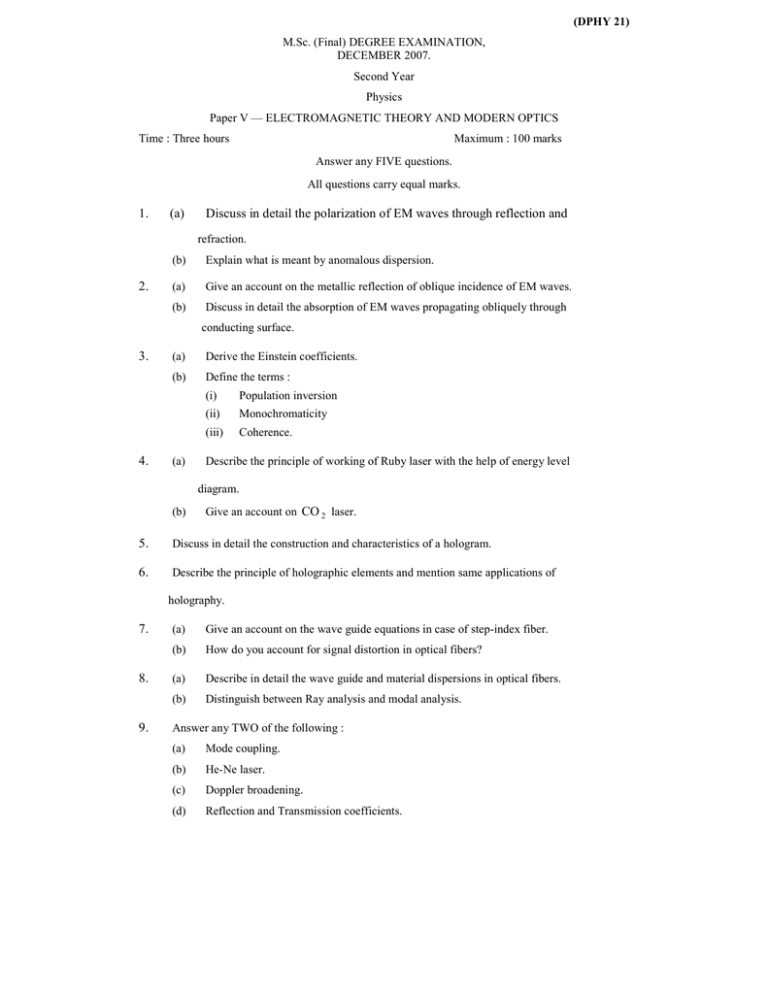
(DPHY 21) M.Sc. (Final) DEGREE EXAMINATION, DECEMBER 2007. Second Year Physics Paper V — ELECTROMAGNETIC THEORY AND MODERN OPTICS Time : Three hours Maximum : 100 marks Answer any FIVE questions. All questions carry equal marks. 1. (a) Discuss in detail the polarization of EM waves through reflection and refraction. 2. (b) Explain what is meant by anomalous dispersion. (a) Give an account on the metallic reflection of oblique incidence of EM waves. (b) Discuss in detail the absorption of EM waves propagating obliquely through conducting surface. 3. 4. (a) Derive the Einstein coefficients. (b) Define the terms : (a) (i) Population inversion (ii) Monochromaticity (iii) Coherence. Describe the principle of working of Ruby laser with the help of energy level diagram. (b) Give an account on CO 2 laser. 5. Discuss in detail the construction and characteristics of a hologram. 6. Describe the principle of holographic elements and mention same applications of holography. 7. 8. 9. (a) Give an account on the wave guide equations in case of step-index fiber. (b) How do you account for signal distortion in optical fibers? (a) Describe in detail the wave guide and material dispersions in optical fibers. (b) Distinguish between Ray analysis and modal analysis. Answer any TWO of the following : (a) Mode coupling. (b) He-Ne laser. (c) Doppler broadening. (d) Reflection and Transmission coefficients. (DPHY 22) M.Sc. (Final) DEGREE EXAMINATION, DECEMBER 2007. Second Year Physics Paper VI — NUCLEAR PHYSICS, MOLECULAR AND RESONANCE SPECTROSCOPY Time : Three hours Maximum : 100 marks Answer any FIVE questions. 1. 2. 3. 4. (a) Explain how the nuclear quadrupole moment is defined. (b) Describe the experimental method used to determine nuclear radius. (a) What is scattering cross-section? (b) Give a qualities description of proton-proton scattering experiments. (a) Explain what is meant by the threshold energy of a nuclear reaction. (b) With a suitable diagram explain the working of a Fission Reactor. (a) Explain what are different multipole radiation and their transition probabilities in gamma decay. 5. (b) What are the selection rules involved in gamma decay? (a) What is the principle of NMR spectroscopy? (b) Write down the Bloch equations and explain their importance in NMR spectroscopy. 6. (a) Using a block diagram explain the working of an ESR spectrometer. (b) What information can be deduced by studying fine structure and hyperfine structure? 7. (a) Write down the expressions for the energy levels of a rigid rotation and nonrigid rotator. (b) What is a symmetric top molecule and explain what information you can obtain from the study of its rotational spectrum? 8. (a) What is an anharmonic oscillator? Describe what type of information you can obtain by studying its vibrational spectrum. (b) 9. Explain the vibrational - rotational spectral features of a diatomic molecule. Write notes on any TWO of the following : (a) Meson theory of nuclear forces. (b) Liquid drop model. (c) Relaxation mechanisms. (d) Assymmetric top molecules. (DPHY 23) M.Sc. (Final) DEGREE EXAMINATION, DECEMBER 2007. Second Year Physics Paper VII — SOLID STATE PHYSICS — I Time : Three hours Maximum : 100 marks Answer any FIVE questions. 1. Discuss crystal point groups and their relationship with space group. 2. 3. 4. (a) Describe the construction of reciprocal lattice of a crystal lattice. (b) Obtain relationships between a , b , c and a , b , c . (a) Obtain dispersion relation for a one dimensional monoatomic chain. (b) Give salient features of the dispersion curve. (a) Narrate the procedure for calculating the frequencies of normal modes in the frame work of a theory based on the harmonic approximation. (b) ‘‘Phonon is the corpuscular representation for a quantum of vibration of energy Ws ( u ) carried by a sound wave’’ explain the statement. 5. Mention the physical phenomena which can not explained by harmonic approximation : Explain the cause of its failure. Obtain expression for coefficient of linear thermal expantion in solids. 6. Explain how energy bonds in solids are formed using wave mechanics. Discuss the occurrence of band gaps in a crystal using Kronig-Penney model. 7. (a) What are different zone schemes drawn for energy bonds? Draw first three energy bonds of a one-dimensional crystal in different-zone schemes. (b) Explain how one can predict whether a solid is a good or bad conductor of Electricity using band structure. 8. (a) Obtain expressions for extrinsic carrier densities in a semiconductor for electrons and holes. (b) 9. Discuss how they depend on temperature. Write note on any TWO of the following : (a) Determination of lattice constants of a crystal. (b) Measurement of phonon dispersion by inelastic neutron scattering. (c) Integrator quantum Hall effect. (d) Thermoelectric effect. (DPHY 24) M.Sc. (Final) DEGREE EXAMINATION, DECEMBER 2007. Second Year Physics Paper VIII — SOLID STATE PHYSICS — II Time : Three hours Maximum : 100 marks Answer any FIVE questions. 1. Give different sources that contribute to the total polarizability of a dielectric constant. Obtain expression for electronic polarizability. Show that the energy absorbed per unit volume is proportional to (w ) and (w ) depends on frequencies in the absorption region and accounts for dispersion. 2. Describe the second-order and first order transition in ferroelectric material through thermodynamic theory. 3. Give different kinds of imperfections existing in a crystal. Obtain expression for defect concentration in Schottky defects and Frenkel defects. 4. What is a Pauli paramagnetism? Show that the susceptibility is independent of temperature in paramagnetic materials. 5. What is the method by which one can achieve a lowest temperature of the order 10 6 K? Explain it by taking suitable theory. 6. What is the source of magnetic interaction? Obtain expression for singlettriplet energy splitting. How the negative values of Jex relate to the antiferrimagnetic behaviour? Explain it from the Heisenberg model. 7. What is meant by Neel Model of ferrimagnetism. Using Neel model obtain relationship between susceptibility and ferrimagnetic curie temperature. 8. Explain temperature behaviour of heat capacity of Aluminium in its normal and super conductivity states. Give the heat capaicty and thermal conductivity properties of a super conductor using energy gap. 9. Write notes on any TWO of the following : (a) Electrostriction. (b) Fullerenes and application of HTS. (c) Determination of magnetically ordered structures. (d) Dielectric constant.
